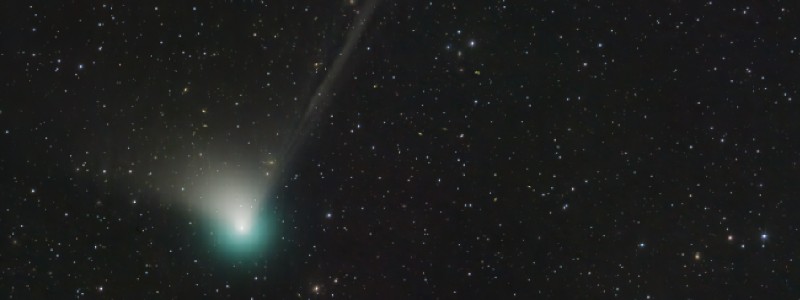How To See Green Comet C/2022 E3 (ZTF)

The rare Green Comet C/2022 E3 (ZTF) is flying by this week for the first time since the Stone Age!
How can I see it?
The best dates and times for viewing will be January 28 through February 4, after 9 p.m. Comet gazers will need a telescope or pair of binoculars to see the object in the sky between the Big Dipper and the North Star in the Little Dipper. In bright areas impacted by light pollution, it will be too faint for naked-eye viewing.
Weather permitting, we’ll look at the comet during our upcoming Free Telescope Viewings on Friday and Saturday night (1/27-1/28 and 2/3-2/4) from 7:30-10:30 p.m. Check our weather station before arrival, because rain or clouds will definitely ruin your chances of seeing the comet. You’ll need clear skies or mostly clear skies. Clouds, haze or fog will prevent viewing.
What makes the comet green?
It is quite common for comets to appear a faint green in color. Comets are icy bodies, but there are several different kinds of ice, not just water ice. As the comet gets close to the Sun, the ice turns to gas in a process we call “sublimation”. The gas forms a cloud (called the coma) that is blown away from the nucleus by the solar wind, forming the comet’s gas tail.
Some forms of comet ice contain carbon compounds that sublimate into a gas that appears greenish in color. Other forms of comet ice can form a bluish-colored coma and gas tail. Both green and blue are common colors for comets.
Why is it rare?
This comet originated in the Oort Cloud, which is a collection of icy bodies orbiting the Sun at the outer fringe of the solar system. It is likely that this comet is in a closed orbit and passed through the inner solar system about 52,000 years ago. It will likely not pass through the inner solar system again for many thousands of years, so this may be our only opportunity to see it.
Generally, there are one or two other comets each year that get close enough to be seen with the naked eye, though they are usually very faint. There are many more comets each year that can be seen with small telescopes.





